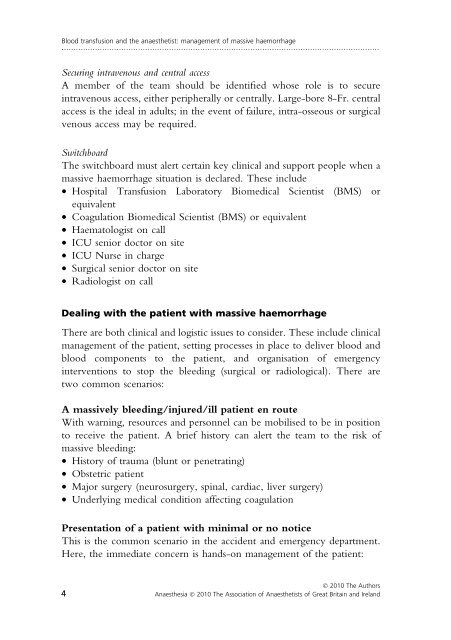Blood transfusion and the anaesthetist: management of ... - aagbi
Blood transfusion and the anaesthetist: management of ... - aagbi
Blood transfusion and the anaesthetist: management of ... - aagbi
Create successful ePaper yourself
Turn your PDF publications into a flip-book with our unique Google optimized e-Paper software.
<strong>Blood</strong> <strong>transfusion</strong> <strong>and</strong> <strong>the</strong> anaes<strong>the</strong>tist: <strong>management</strong> <strong>of</strong> massive haemorrhage<br />
.....................................................................................................................................<br />
Securing intravenous <strong>and</strong> central access<br />
A member <strong>of</strong> <strong>the</strong> team should be identified whose role is to secure<br />
intravenous access, ei<strong>the</strong>r peripherally or centrally. Large-bore 8-Fr. central<br />
access is <strong>the</strong> ideal in adults; in <strong>the</strong> event <strong>of</strong> failure, intra-osseous or surgical<br />
venous access may be required.<br />
Switchboard<br />
The switchboard must alert certain key clinical <strong>and</strong> support people when a<br />
massive haemorrhage situation is declared. These include<br />
• Hospital Transfusion Laboratory Biomedical Scientist (BMS) or<br />
equivalent<br />
• Coagulation Biomedical Scientist (BMS) or equivalent<br />
• Haematologist on call<br />
• ICU senior doctor on site<br />
• ICU Nurse in charge<br />
• Surgical senior doctor on site<br />
• Radiologist on call<br />
Dealing with <strong>the</strong> patient with massive haemorrhage<br />
There are both clinical <strong>and</strong> logistic issues to consider. These include clinical<br />
<strong>management</strong> <strong>of</strong> <strong>the</strong> patient, setting processes in place to deliver blood <strong>and</strong><br />
blood components to <strong>the</strong> patient, <strong>and</strong> organisation <strong>of</strong> emergency<br />
interventions to stop <strong>the</strong> bleeding (surgical or radiological). There are<br />
two common scenarios:<br />
A massively bleeding/injured/ill patient en route<br />
With warning, resources <strong>and</strong> personnel can be mobilised to be in position<br />
to receive <strong>the</strong> patient. A brief history can alert <strong>the</strong> team to <strong>the</strong> risk <strong>of</strong><br />
massive bleeding:<br />
• History <strong>of</strong> trauma (blunt or penetrating)<br />
• Obstetric patient<br />
• Major surgery (neurosurgery, spinal, cardiac, liver surgery)<br />
• Underlying medical condition affecting coagulation<br />
Presentation <strong>of</strong> a patient with minimal or no notice<br />
This is <strong>the</strong> common scenario in <strong>the</strong> accident <strong>and</strong> emergency department.<br />
Here, <strong>the</strong> immediate concern is h<strong>and</strong>s-on <strong>management</strong> <strong>of</strong> <strong>the</strong> patient:<br />
Ó 2010 The Authors<br />
4 Anaes<strong>the</strong>sia Ó 2010 The Association <strong>of</strong> Anaes<strong>the</strong>tists <strong>of</strong> Great Britain <strong>and</strong> Irel<strong>and</strong>

















